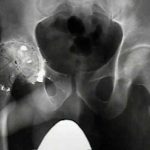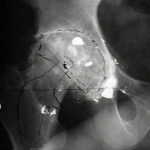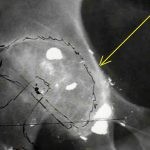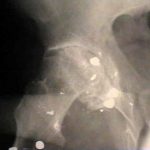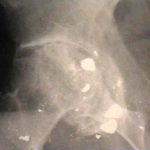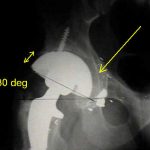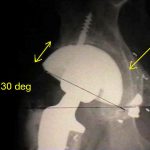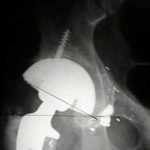Discussion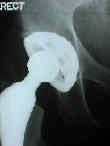
- restoration of normal hip center in acetabular reconstruction encourages restoration of normal biomechanics;
- placing the socket laterally creates increased joint reactive force, and placing it directly superior requires the use of a long neck prosthesis to restore abductor moment arm;
- long neck prosthesis will develop increased lateral bending stresses, adapting to the activities of daily living;
- acetabular component must be positioned in anatomic position at level of true notch to reduce stresses and increase longevity;
acetabular component abduction / inclination »
acetabular component anteversion »
- combined anteversion (combined femoral anteversion and acetabular anteversion) has received recent attention in several studies;
- references:
component dislocation »
- safe range: prevents impingement and component dislocation;
- safe range for cup flexion that would allow physiologic ROM w/o impingement w/ cup fixed in 40 deg abduction and 20-40 deg anteversion;
- position of 45 deg abduction & 30 deg flexion allowed flexion of hip to 90 deg & IR to 90 degrees without impingement;
- references:
ROM
- main goal is to avoid impingement which would occur with activities of daily living;
- references:
- The effect of the orientation of the acetabular and femoral components on the range of motion of the hip at different head-neck ratios.
- Compliant positioning of total hip components for optimal range of motion.
- Impingement with Total Hip Replacement
- The spatial location of impingement in total hip arthroplasty.
- Guidelines for implant placement to minimize impingement during activities of daily living after total hip arthroplasty.
Surgeon Related Error
- references:
- Comparison of Conventional Versus Computer-Navigated Acetabular Component Insertion.
- The accuracy of free-hand cup positioning--a CT based measurement of cup placement in 105 total hip arthroplasties.
- Comparison of a mechanical acetabular alignment guide with computer placement of the socket.
- The definition and measurement of acetabular orientation.
References
- Total hip acetabular component position affects component loosening rates.
- Comparison of two- and three-dimensional methods for assessment of orientation of the total hip prosthesis.
- Reconstruction of the hip. A mathematical approach to determine optimum geometric relationships.
- Determination of Acetabular Coverage of the Femoral Head with Use of a Single Anteroposterior Radiograph. A New Computerized Technique.
- The relationship between the design, position, and articular wear of acetabular components inserted without cement and development of pelvic osteolysis.
- Anatomic Referencing of Cup Orientation in Total Hip Arthroplasty.
- Using Intraoperative Pelvic Landmarks for Acetabular Component Placement in Total Hip Arthroplasty.
- Does Native Hip Anatomy Fit Recommendations for Safe Component Orientation in THA?
Case Example
- 35-year-old male w/ near anklyosed hip following a GSW to the hip;
- preoperative films appeared to indicate that little or no medialization was necessary;
- postoperative films, however, indicate that the cup was lateralized (hence, reaming was inadequate);
- in retrospect, the radiographs which are rotated externally (like an iliac oblique) tend to falsely minimize the necessary amount of medialization where as X-rays which are rotated internally (like an obturator oblique), tend to over-estimate the necessary amount of medialization


